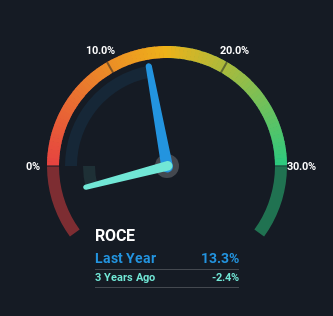TETRA Technologies (NYSE:TTI) Shareholders Will Want The ROCE Trajectory To Continue
If we want to find a potential multi-bagger, often there are underlying trends that can provide clues. One common approach is to try and find a company with returns on capital employed (ROCE) that are increasing, in conjunction with a growing amount of capital employed. Ultimately, this demonstrates that it's a business that is reinvesting profits at increasing rates of return. With that in mind, we've noticed some promising trends at TETRA Technologies (NYSE:TTI) so let's look a bit deeper.
Return On Capital Employed (ROCE): What Is It?
For those who don't know, ROCE is a measure of a company's yearly pre-tax profit (its return), relative to the capital employed in the business. The formula for this calculation on TETRA Technologies is:
Return on Capital Employed = Earnings Before Interest and Tax (EBIT) ÷ (Total Assets - Current Liabilities)
0.13 = US$46m ÷ (US$472m - US$127m) (Based on the trailing twelve months to September 2023).
So, TETRA Technologies has an ROCE of 13%. In absolute terms, that's a pretty normal return, and it's somewhat close to the Energy Services industry average of 12%.
See our latest analysis for TETRA Technologies
Above you can see how the current ROCE for TETRA Technologies compares to its prior returns on capital, but there's only so much you can tell from the past. If you're interested, you can view the analysts predictions in our free report on analyst forecasts for the company.
So How Is TETRA Technologies' ROCE Trending?
We're pretty happy with how the ROCE has been trending at TETRA Technologies. The data shows that returns on capital have increased by 595% over the trailing five years. That's a very favorable trend because this means that the company is earning more per dollar of capital that's being employed. In regards to capital employed, TETRA Technologies appears to been achieving more with less, since the business is using 71% less capital to run its operation. If this trend continues, the business might be getting more efficient but it's shrinking in terms of total assets.
On a side note, we noticed that the improvement in ROCE appears to be partly fueled by an increase in current liabilities. Essentially the business now has suppliers or short-term creditors funding about 27% of its operations, which isn't ideal. It's worth keeping an eye on this because as the percentage of current liabilities to total assets increases, some aspects of risk also increase.
The Bottom Line On TETRA Technologies' ROCE
In the end, TETRA Technologies has proven it's capital allocation skills are good with those higher returns from less amount of capital. Since the stock has returned a staggering 231% to shareholders over the last five years, it looks like investors are recognizing these changes. In light of that, we think it's worth looking further into this stock because if TETRA Technologies can keep these trends up, it could have a bright future ahead.
TETRA Technologies does have some risks though, and we've spotted 1 warning sign for TETRA Technologies that you might be interested in.
For those who like to invest in solid companies, check out this free list of companies with solid balance sheets and high returns on equity.
Have feedback on this article? Concerned about the content? Get in touch with us directly. Alternatively, email editorial-team (at) simplywallst.com.
This article by Simply Wall St is general in nature. We provide commentary based on historical data and analyst forecasts only using an unbiased methodology and our articles are not intended to be financial advice. It does not constitute a recommendation to buy or sell any stock, and does not take account of your objectives, or your financial situation. We aim to bring you long-term focused analysis driven by fundamental data. Note that our analysis may not factor in the latest price-sensitive company announcements or qualitative material. Simply Wall St has no position in any stocks mentioned.

